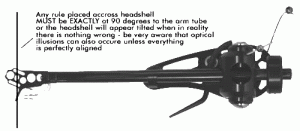Tonearm Dual Pivot Bearing
Why a Dual Pivot Bearing?
The Encounter, Illustrious and Conqueror tonearms are performance leaders, partly by virtue of their innovative dual-pivot bearing. These bearings are attached to the horizontal axle (which governs vertical arm movement). This design is similar in many respects to uni-pivot designs-low friction and high decoupling which give excellent definition and transparency. However, uni-pivots can be difficult to set up. Dual pivots have all the advantages of uni-pivots but none of the drawbacks. Vertical movement of the arm is handled by the dual-pivot and horizontal movement by highly specified conventional bearings.
Understanding Dual Pivot
The pivot bearings are designed to reduce friction to an absolute minimum. In doing this there is a fine balance between achieving both a long-lasting, robust design and realising the potential of extremely low friction. In practice, this means that the arm must have a tiny degree of movement due to a rounded tungsten point in a hardened steel cup. The pivot points will “self-centre” by sliding into the bottom of the low friction cup.
Understanding the Clarity and Definition delivered by Dual Pivot Bearings
Dual pivot bearings are one of the many innovations which make Origin Live arms performance leaders. The design is similar in many respects to uni-pivots – low friction and high decoupling yield excellent definition and transparency. However, uni-pivots can be fiddly to set up and exhibit only mediocre bass performance because of their relative instability. Dual pivots have all the advantages of uni-pivots but none of the drawbacks. Vertical movement of the arm is handled by the dual-pivot and horizontal movement by highly specified conventional bearings.
Handles like a conventional gimballed arm
The arm functions and handles in exactly the same way as a conventional gimballed arm. In other words, you do not need to worry about setting up an azimuth. The azimuth is set at the factory (for those unfamiliar with the term, azimuth is the measure of headshell “twist” relative to the record surface).
How dual-pivot works
[insert image/illustration here]
The above illustration of the dual-pivot bearing shows the needle pivots resting in their cups and allowing the arm to pivot and thus allow vertical movement. The pivots are designed to reduce friction to an absolute minimum. In doing this there is a fine balance to achieve both a robust design whilst maintaining extremely low friction. In practice, the arm must have a slight degree of movement due to a sharp tungsten point in a shallow radius bearing cup. The alternative to this is a very sharp point in a deep v-shaped cup (this would certainly restrain the movement of the point but would also increase friction and potential fracture of the tips).
The pivot points will “self-centre” by sliding into the bottom of the pivot cups.